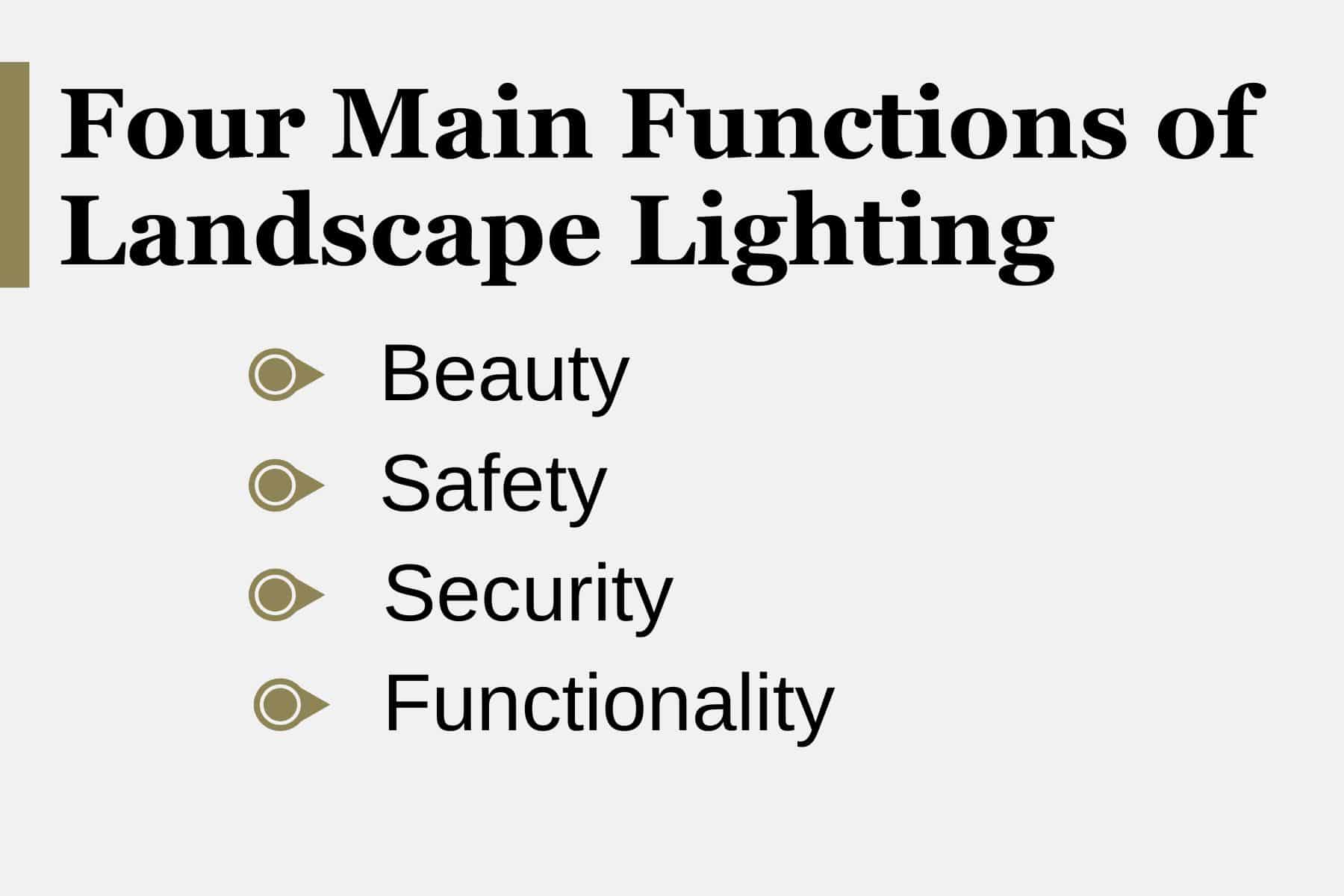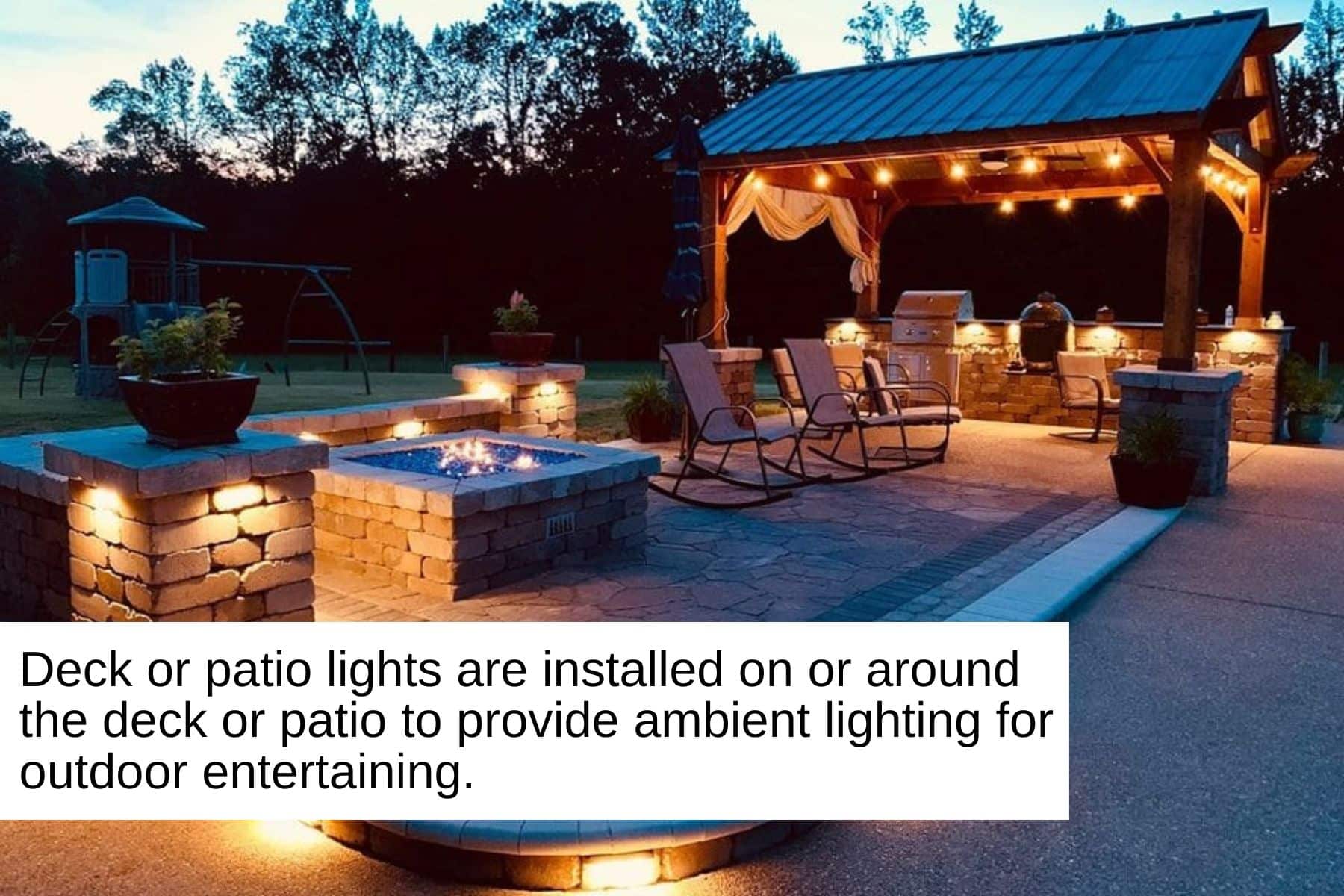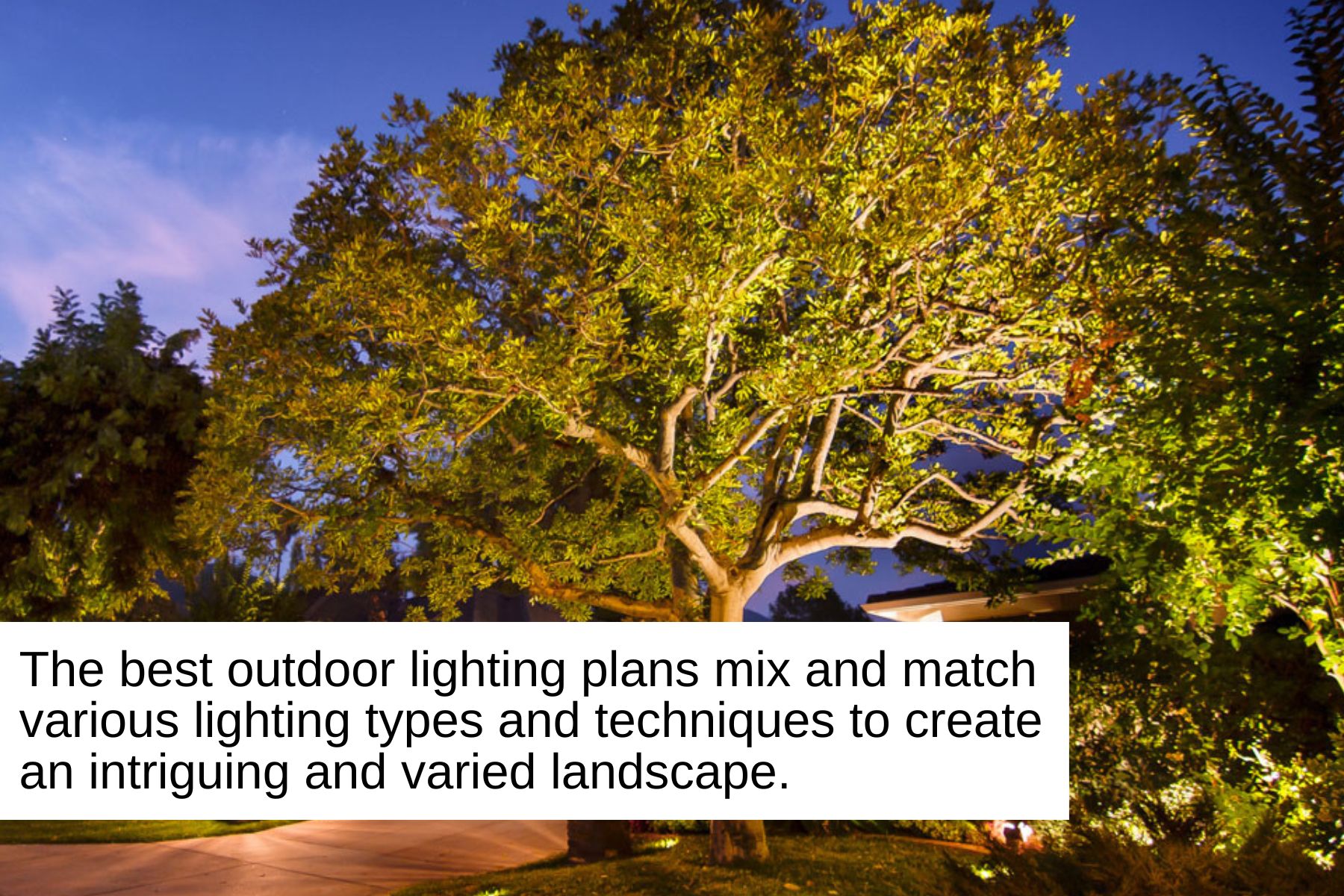A Guide To Landscape Lighting: Types, Techniques, and Tips
At Zimmerman Mulch, we know that you want to take pride in the appearance of your property, both day and night.
To enhance your property’s nighttime charm, you need landscape lighting! Not only does landscape lighting make your property more magical and beautiful, but it also increases safety and security.
In this article, we’ll guide you through the benefits, types, planning, and maintenance of landscape lighting systems so you can make informed decisions about landscape lighting for your property.
Ready to get started?
Let’s go!
Why Is Landscape Lighting Important?
We all know landscape lighting can be pretty, but does it accomplish anything more than merely increasing aesthetics?
Yes, it does!
There are four main functions that landscape lighting plays at any property:
- Beauty
Landscape lighting enhances your home's beauty by highlighting its best features, such as an archway or decorative wall, and adds depth and dimension to your property.
It also creates a lovely ambiance and sets "the mood." Think about it: Soft, warm light makes you want to settle down for a romantic evening, whereas dynamic colored lighting gets you pumped up for a party with your friends. The tone of the light can set the tone of the evening.
That's the power of lighting!
- Safety
If your guests come to your house, you don't want them stumbling along your sidewalk and up your stairs in the dark! Strategically placed lighting increases safety by illuminating walkways, stairs, and other potential hazards, decreasing the risk of trips and falls. It also helps your home seem more inviting and welcoming to your guests.
- Security
Intruders and wildlife can easily approach your home under the cover of darkness. Landscape lighting provides a layer of security to your property by illuminating dark areas around your home, deterring unwanted intruders, and allowing you to keep an eye on things from the inside.
In fact, crime rates are shown to drop in well-lit places, which is why college campuses and store exteriors are always lit up. One study conducted in NYC showed that crime rates dropped by 39% in well-lit areas vs. darker areas.
- Functionality
Without landscape lighting, you must stop using your outdoor spaces after nightfall and go inside. But a little lighting allows you to stay outside safely and comfortably and enjoy not only the days but also the nights.
As you can see, landscape lighting is more than just an aesthetic element and can also provide essential safety, security, and functionality for your space.
In the next section, we will look at the different types of landscape lighting.

8 Types Of Outdoor Lighting
If you have already started researching how to light your landscape, you know that it's not exactly straightforward. The internet is strewn with different types, techniques, and tips for landscape lighting.
That can look pretty overwhelming, right?
We aren't here to say it's simple because creating the perfect landscape lighting plan takes a bit of time and skill. But we are here to help you get a better handle on it!
For the following two sections, we put together two lists: one of 8 types of lighting and one of 7 techniques for using said lighting types. Mix and match the outdoor lighting types and techniques to create different effects.
Here are a few outdoor lighting types:
1 - Spotlights - Spotlights are directional lights that focus a narrow beam of light on a specific feature in your landscape, such as a tree, statue, or flag. They are great for highlighting focal points and creating dramatic effects.
2 - Floodlights - Floodlights are very functional but less attractive and romantic than other types of light. They provide a broad, even spread of light and are often used to illuminate large areas like driveways, walkways, and walls. They can also be used for security purposes to deter intruders.
3 - Stair lights - Installed on the risers of steps or along the edge of stair treads, stair lights provide safety and guidance at night. They can also add an element of style to your landscape.
4 - Deck or patio lights - Deck or patio lights are installed on or around the deck or patio to provide ambient lighting for outdoor entertaining. They allow you to see your friends' faces while you visit! You can install them on posts, railings, or the deck itself.

5 - Hardscape lights - Installed in walls, pillars, or other hardscape elements, hardscape lights create a warm and inviting atmosphere. You can also use them to highlight architectural features and add depth to your landscape.
6 - Water lights - Water lights are installed in or around water features like ponds, fountains, or pools to create a beautiful and calming effect at night. They can also improve safety around water features.
7 - Post lights - You can mount post lights on top of posts or pillars to provide a decorative touch and add extra lighting to your landscape. They are often used to line driveways or walkways.
8 - Inground lights or well lights - Inground lights, also known as well lights, are installed in the ground to provide discreet lighting for flags, trees, shrubs, or other landscape features or to highlight architectural features.
7 Techniques For Using Outdoor Lighting
Now that we know about the main types of outdoor lighting, here are the techniques you can use to make your landscape come alive:
1 - Uplighting - Uplighting involves placing a light fixture at the base of a tree or other object and shining the light upward to create a dramatic effect. This technique is often used to highlight the texture and shape of the object.
2 - Downlighting - Downlighting is the opposite of uplighting. The idea of downlighting is to place a light fixture above an object and shine the light downward. This technique creates a soft, natural-looking illumination and often highlights pathways, decks, and patios.
3 - Shadowing - Shadowing involves placing a light fixture at an angle to create a dramatic shadow effect on a nearby surface, such as a wall or fence. This technique can add depth and drama to your landscape.
4 - Silhouetting - Silhouetting is when you place a light fixture behind an object to create a dark silhouette against a bright background. You can use this technique to create a dramatic effect or to hide unattractive things.
5 - Moonlighting - If you want a soft, natural-looking illumination that creates a romantic or mystical atmosphere, try moonlighting! Moonlighting is when you place a light fixture high up in a tree and shine the light downward to create the effect of moonlight filtering through the branches. It creates intriguing shadow patterns on the ground.
6 - Grazing - Grazing involves placing a light fixture close to a textured surface, such as a stone wall or tree bark, and shining the light across the surface at a low angle to highlight its texture. This technique can create a dramatic effect and add depth to your landscape.
7 - Washing - To wash a surface, such as a wall or a fence, place a light fixture at a distance from the surface and shine the light across the surface at a high angle to create a soft, even illumination. You can use this technique to create an ambient, welcoming atmosphere.
The best outdoor lighting plans mix and match various lighting types and techniques to create an intriguing and varied landscape.

Other Tips To Think About
Here are a few other aspects of landscape lighting you should think about when creating your plan and selecting your lights:
Light color - Lights come in different colors–some are warmer, some are cooler, and some are an actual color, such as blue or purple. Whether you want warm, cool, or colored light depends on what look you want in your landscape.
Light strength - If you want to illuminate a tree from the roots up, you’ll need a lot more power than if you want to shed a little glow on your pathway.
Efficiency - It costs money to power lights, so you probably want to utilize the most efficient lighting system possible, such as an all-LED system.
Motion sensing vs. timed controls - Since you don’t want to waste energy by keeping your lights on all the time, you may want to consider either motion sensors or a control system where your lights come on at certain times. You can even combine both methods for motion-sensing lights that only operate after dark.
This is just a bird’s eye view of landscape lighting, and more nuance and skill go into creating a beautiful scene. If you want more help with your property, you can always ask an experienced landscaper for more tips and advice.
Conclusion
Wow, we covered a lot of information! If you can retain and utilize these lighting types, techniques, and tips, you are well on your way to a beautifully lit property.
If you want landscape lighting supplies today, take a look at the Zimmerman Mulch website. We offer a variety of lighting options, as well as other landscaping and outdoor living supplies, including:
And more! Visit the store today–we look forward to hearing from you!



